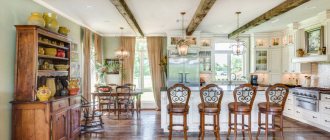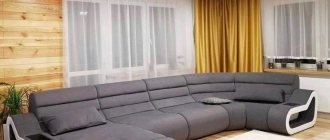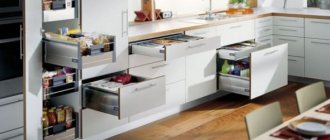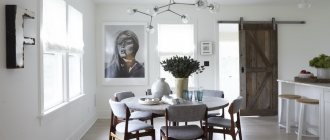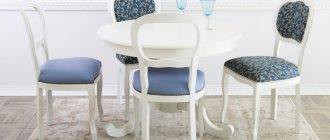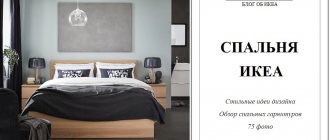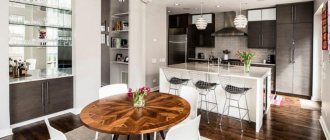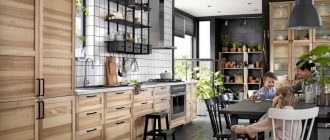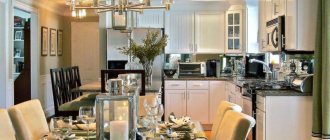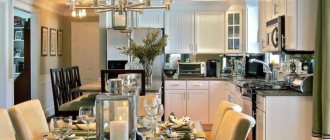Published: 10/11/2020 11469 views The old generation knows very well what a sideboard is and happily continues to use this piece of furniture. Young people consider it “mothballs”, suitable only for a dacha or an apartment in which older people live. Old models can really give such an impression, but there are also modern ones that will fit perfectly into any interior and cope with their functions!
Let's look at stylish kitchen sideboards, learn about the different types, designs and find the best solutions for different occasions.
Purpose, advantages and disadvantages of a kitchen buffet
Essentially, what is a buffet? Cabinet for storing kitchen appliances, dishes and textiles. It can be open or closed, of different sizes, with a large or small number of compartments.
Among the advantages of such a cabinet:
- Convenience. Everything is at hand. There are models with an impromptu table on which you can place plates and cups before serving, cut something small, and brew tea.
- Capacity. Despite their compactness, buffets are usually very spacious. They have a lot of shelves for food, services, and a variety of drinks.
- Versatility. The choice is huge, so you can safely use it in different rooms and styles.
The disadvantages are high prices for quality products and bulkiness. Let's say right away that in many cases the cost is justified, because this item is purchased for decades. Large dimensions are not a hindrance for a spacious kitchen or living room; in addition, small models are now being produced.
Where to install the buffet?
One of the most logical and therefore popular locations of a buffet is in the kitchen space as a continuation of the furniture set. In this case, the buffet can be installed along the wall and continue the kitchen ensemble, or have a perpendicular location and outline the boundaries of the functional sector.
Most often, dishes, cutlery and other serving items are stored in the buffet, so it is most logical to place this piece of furniture near the dining group. The table for meals can be located in the kitchen space or be the focal point of a separate room - the dining room. Regardless of the installation of the dining ensemble, a buffet can accompany it in any area.
Another option for installing a buffet or sideboard is on the border of functional areas. This can be either an element of zoning the kitchen into a dining and work area, or part of a combined room in which three functional segments are located at once - kitchen, dining room and living room. In the case of zoning a large space, the buffet can be located either along the wall or perpendicular to the vertical plane, clearly separating the kitchen work area from the dining room or living room.
In some cases, it is more rational to use two narrow cupboards rather than one bulky cabinet. In this case, a pair of sideboards can be located on two sides of a window or doorway, or any other interior element. Obviously, such an arrangement will not only help to rationally use the usable space of the dining room or kitchen, but will also emphasize the traditional style with symmetry.
If there is a niche in your dining room or kitchen, then not using it to install a buffet is simply a sin. Finding a ready-made furniture solution for the existing niche dimensions will not be easy, but making a custom-made buffet to suit your requirements will solve not only the problem of dimensions, but also stylistic execution.
In some rooms, the buffet is not connected either to the kitchen unit or to the dining group. Any free space in a spacious room can be a good installation option. Of course, it is desirable that this sector is not remote from the dining area - it is more convenient to set the table if all the items are “at hand”.
How to choose a cupboard for dishes in the kitchen?
First decide on the type: closed or open. When closed, the shelves are covered with doors. If you do not hide the contents from yourself and others, order models with doors made of translucent or completely transparent glass.
An open buffet does not have doors, but it can have a comfortable tabletop.
When choosing, you need to pay attention to:
- Style. Designers will recommend products that are ideal for the overall design of the room. They will find models made in Scandinavian, country, classic or modern style. If you don’t want to turn to specialists or adhere to a strict style, simply replace the fittings later.
- Structure. Decide right away what exactly you will store inside. What things should be visible? Display cabinets are good for admiring beautiful sets, and with a table top for keeping tea “accessories” in one place.
- Color. Think about what is more important to you: being on trend or using time-tested, always up-to-date options. Do you like a calm, balanced environment or a non-boring one with bright accents?
- Capacity. In a small kitchen, a sideboard and cabinets near the sink are often enough. In this case, choose the most spacious models.
It is very important to weigh everything well and not make momentary decisions - this is a purchase for many years to come! In addition, professionals recommend choosing the size and shape of the buffet, focusing on the surrounding objects, so that it stands out from the crowd. If there is little furniture in the room, take a closer look at cute accessories, for example, flower pots and flowerpots with house plants.
The color should not be the same as that of the flooring, but a color similar to the dining table, set and chairs is welcome. In houses with porous walls, wall display cabinets are often used.
And the most important thing is practicality. Then you constantly have to put something in and take it out, wipe it, so learn more about the designs and materials, opening and closing mechanisms. Ease of maintenance, reliability and versatility are a priority.
An old buffet can become new
If you are the lucky owner or you already have an old buffet, don’t throw it away. Do the restoration yourself. You are not a creative person - don’t be too upset.
Just paint it a bright color. It will complement your interior. Wooden cabinets should not be painted. Clean and varnish.
But of course it’s better to contact a restorer who will do it right for you. And it will be financially more profitable than buying a new buffet.
Straight kitchen design with cabinets up to the ceiling- What material are kitchen sets made of?
Kitchens with patina: decor options and tips on color combinations
When choosing a cabinet, you must take into account the basic style decisions of the room. The color and texture must be combined with the existing furniture in the kitchen; the shape of the room also matters.
Now there are buffets for bathrooms. A very interesting idea. The role of the cabinet under the washbasin. Storage of towels and other bathroom accessories.
Why do you need a display buffet for the kitchen?
A showcase is an open cabinet with shelves and glass doors. There are floor-mounted ones, in the form of narrow high pencil cases, and rectangular, square “extensions” that are placed on kitchen cabinets.
Most often, display buffets are placed in the dining area. In the living room they also perform a decorative function. They store and at the same time display to others expensive porcelain and crystal sets, souvenirs, and memorabilia.
Showcases made from solid wood are considered the most durable, expensive and environmentally friendly, high-quality and cheaper are made from MDF, and budget ones are made from chipboard. In modern interiors, bright cabinets are installed that help create an interesting contrast. Behind glass doors you can hide cute figurines, awards, and in closed compartments you can find napkins, towels and cutlery.
Closed structures
Closed versions always have doors, but not necessarily with solid doors. They can have windows made of glass or mesh material. In such storage systems, dust ingress is reduced to zero. Which is conducive to storing expensive holiday services.
Sideboards with solid doors look massive, so glazed options are better suited for miniature kitchens.
What is good about a buffet rack for the kitchen?
This is an additional useful area and a tool for zoning space.
Now the buffet rack comes in the form of:
- sections that resemble a stepladder;
- metal or wooden structures with shelves;
- mobile structures with wheels and locks;
- cabinets with perforated drawers;
- sections dividing the room into different functional areas.
It is customary to store dishes, spices, cereals, bottles and jars, towels and cleaning products here. You need to understand that the rack a priori holds fewer shelves, is not protected from dust and is open to everyone, including guests, pets and children.
Wooden kitchen cupboard racks fit perfectly into interiors designed in eco-friendly and rustic styles. Plastic ones are very practical and convenient; they store fruits and vegetables and drinks. They will look natural in eclectic rooms decorated in hi-tech style.
Antique buffet for the kitchen in Provence or country style
A sideboard cabinet is ideal for a kitchen in Provence or country style, even if its color does not match the rest of the kitchen cabinets. The top shelves of the buffet can be used to store cups, decorative plates, spice jars, tea boxes and various accessories. The spacious shelves below are perfect for storing large kitchen utensils such as cans of cereal, pots and pans. In order for the buffet to fit into the decor in the best possible way, it is better to cover it with the same tabletop as the rest of the lower cabinets in the kitchen. Vintage curtains and wall décor complete a charming, country-inspired kitchen design.
Also read: New ideas for using old furniture and other things
Corner cupboard for kitchen utensils
This is an addition to the kitchen set, a place where it is a priori customary to place dishes. Classic models of corner buffets consist of a top and a bottom. There are glass doors at the top and solid doors at the bottom. Laconic and intricate shapes, narrow radius buffets are equally appropriate.
Corner kitchen models can be equipped with a drying rack, rubberized substrates, and railing systems made of tubes and hooks. Plastic and metal grilles and trays, which are closed in the lower part of the product, are also appropriate. Drawers will also come in handy.
Open buffet models
Opened buffets do not have doors in the upper compartment of the structure.
- Most often, the upper section consists of shelves, glass holders, and baskets.
- The main disadvantage of this design is the accumulation of dust.
- Such storage systems are intended for regular use.
- For example, for storing dishes used daily.
The most suitable buffet for a small kitchen
As a rule, buffets are installed in rooms with a large area, but there are many exceptions to the rules. Manufacturers offer a good selection of compact models, and designers offer methods for visually expanding space.
Small cabinets will look best in a corner or against a wall, so they won't take up precious square footage and won't seem bulky. As for color, experts recommend blue tones. They refresh, calm, brighten and enlarge the room.
Blue, green, yellow or white sideboard for the kitchen?
A blue classic wardrobe is the choice of extraordinary individuals and fans of nautical style. It looks attractive, calms, and makes the kitchen bright and original. Buffets with greenish, sage shades are called “chameleons”: they change color in different lighting and in any case belong to the basic ones. Such tones advantageously complement others, rather than dominate.
A white buffet is associated with traditional cuisine. Pairs especially well with black stone countertops. Bright yellow products make the interior luxurious. For a vintage feel, cabinets feature wrought iron handles in a warm buttery color paired with marble countertops. But buffets made from pale green and yellow tones will give the kitchen or living room a playful, unusual mood.
In such a room it is always cozy, easy, negative emotions fade into the background.
If you are conservative, go for gray. Yellow chairs and gilded decor will help make it more expressive.
What materials are kitchen buffets made from?
The materials used to make the original corner cabinet are:
- natural wood;
- MDF;
- laminated chipboard;
- plywood.
The fittings and decor of the structure are made of metal, plastic, glass, including stained glass, acrylic, and ceramics.
To make a kitchen corner buffet, you can use different materials.
See alsoWhich coffee grind is best for a coffee machine
Durable and beloved by many kitchen buffets made of wood
Classic and modern cupboards are safe, durable and versatile. Natural wood is an environmentally friendly material that is not harmful to health. It is reliable and allows you to implement almost any design ideas.
The most popular wood species for the production of chests of drawers:
- Oak. Expensive, durable, with a beautiful texture. It is resistant to rotting and initially endowed with decorative properties.
- Red tree. Belongs to elite varieties. It is distinguished by aesthetics, elegance and practicality. It is durable and not susceptible to adverse factors.
- Pine. Beige, white or brown wood is easy to process and glue. Finished pine products are finished with hardwood veneer or varnished.
- Ash. After steaming it becomes plastic, does not crack when dried, but is difficult to polish.
Alder, birch, larch, hornbeam, and walnut are also used. Good budget options are pine and birch. The color palette, choice of fittings, shape and decor will depend on the style. Classic wooden sideboards, usually with stucco, gold handles or gilded decor, light pastel colors, inserts on the facades.
Products made in country style combine strict shapes and lines with rustic comfort; there is no special “embellishment”, brightness or originality. Provence is difficult to imagine without forged inserts, carved details, neutral beige colors and monograms.
Buffet and its use in different styles
Corner sideboards are suitable for an ordinary kitchen decorated in various interior styles:
- Baroque - the buffet is richly decorated with wood carvings, glass and stone mosaics;
- classic – made of light wood, with applied carved parts;
- Provence – white, draperies in the upper part behind the glass are acceptable;
- rustic - a rough product without finishing;
- minimalism - a product made of MDF, a strict, laconic form, no decor;
- loft – heavy wooden cabinet artificially aged.
A charcoal buffet can be successfully combined with different interior styles.
Advice. The buffet design is not suitable for modern style, hi-tech, futurism, techno.
See alsoDesign of a kitchen-living room with an area of 16 square meters. m.
Fashionable vintage kitchen buffets again
Antique and at the same time “modern” cabinets for dishes in rich, bright colors are experiencing a “rebirth”. Retro style has made its way here too.
Many began to regret throwing away old chests of drawers, tables, chairs and grandma's cupboards. The wooden models are definitely well preserved from the 50-70s of the last century. There is no need to artificially age them, just give them a little shine and think carefully about how to “frame” them.
But, of course, such an idea will appeal only to fans of antiquity, people who are not averse to being nostalgic or who regret throwing away memorable, albeit unsightly, things, who organically coexist with antiques. If you want to recreate the atmosphere of the 60s, look for models with floral prints, the 70s - intricate ones with varnished wood, the 50s - bright, solid colors with a strict geometric shape.
Buffet decor
A wooden cabinet is decorated in different ways:
- volumetric wood carving;
- overhead plastic elements;
- stained glass;
- covered with paint, stain, varnish;
- signed by hand.
Using decoration, you can give a unique look to an antique buffet.
Very popular are products that imitate antique ones - with paint peeled off here and there, applied in several layers, decorative abrasions right down to the wood, and areas decorated using the “crackle” technique. Some models have interior decorative lighting.
See alsoFeatures of an induction cooker: power, electricity consumption
Does the USSR buffet look natural in a modern kitchen?
If you have a maximum of two vintage items in your room, yes. Good options: a combination of a retro floor lamp and an armchair, a dining set for sleeping or dining with a dressing table, which will sit comfortably in the corner. Soviet furniture is organic in retro, minimalism, loft, as well as Scandinavian, classic styles and Provence.
A Provence kitchen always has a large wooden buffet. It can be turquoise, beige, olive or lilac.
It is often painted, and the surrounding space is filled with soft wooden retro chairs and a massive table. Furniture made from fiberboard from the times of the USSR is often restored using decoupage cards, opaque paint, and film with a pattern. If there are no scratches or cracks, simply periodically polish and replace the fittings.
Which style to choose
Whatever style is used in interior design, there is always a suitable kitchen cupboard option.
Today, the market provides a wide selection of models, with different shades, styles and decorations. But, when you need something non-standard, you can order the product from a furniture maker.
We list the main options for certain interiors:
- Classic. Expensive furniture made from natural wood looks good in this style. The facades of which are decorated with ornate carvings, gilded chamfers and other decorative elements. Such furniture will add sophistication to the overall look of a room in a classic style.
- Country. Furniture for a room of this style is chosen without decorative ornaments. The main features of such a buffet are convenience and functionality. Lots of spacious compartments, the best choice for a rustic kitchen.
- Provence. Particular attention is paid to the color scheme. When choosing a Provence buffet for the kitchen, preference is given to white, but pastel colors are also suitable. Aged surfaces and small decorations are quite appropriate.
- Modern. In a kitchen designed in a modern style, furniture made from new materials is chosen. Wood is replaced by chipboard, MDF. And glass surfaces are being replaced by plastic.
What is it like - a modern style kitchen buffet?
It is very different from Soviet and vintage in general. This type of dish cabinet does not need to be polished to a mirror finish and is conveniently integrated into the design. It has attractive fittings, no splitting into sections, curls, pretentious shapes, or gilding. Today's models are ideal for Provence, minimalism and loft.
Minimalism is characterized by regular cubic shapes and unusual design as decor. Many people, for example, like the glass center, which looks like an aquarium. Art Nouveau is easy to recognize by its smooth lines, brown and black colors, multi-colored glass or its complete absence, unusual shape and carved elements.
Models in the loft style are non-standard, milky tones or black, metal with mesh door leaves. They have thin legs, metal decor and inserts, and artistic forging is also found.
PERFORMA | VIP sofas offer you a large selection of cabinets and shelving for living rooms, kitchens and other rooms. You can choose a model of any size, sort products by cost, manufacturer, novelty and popularity. To complement the stylish buffet, you can also choose a small cozy sofa or ottoman. At your service are also exclusive options and the opportunity to order the production of furniture according to an individual project!
Expert: Nadezhda Gumennaya
Styles of antique sideboards and their role in the interior
